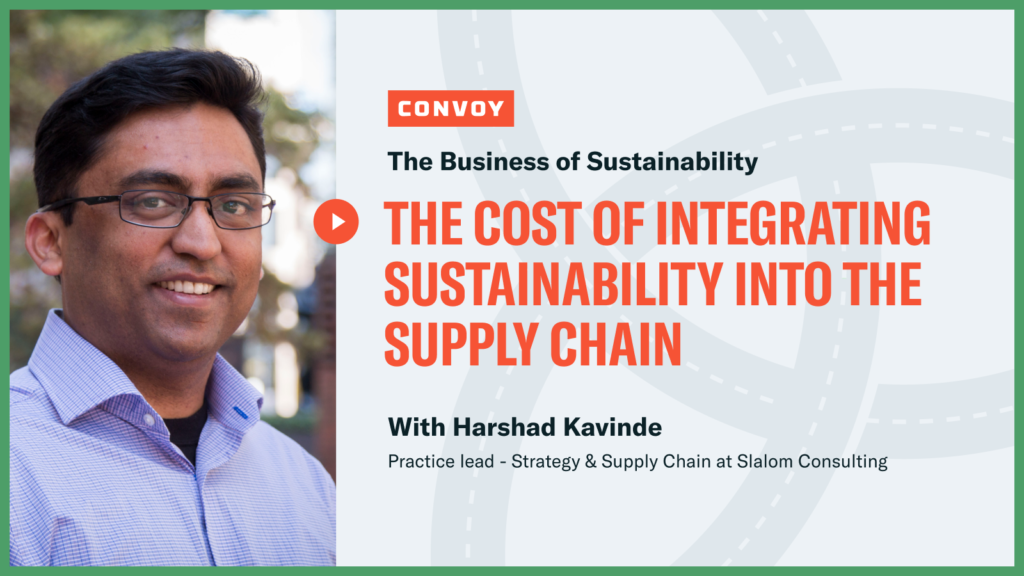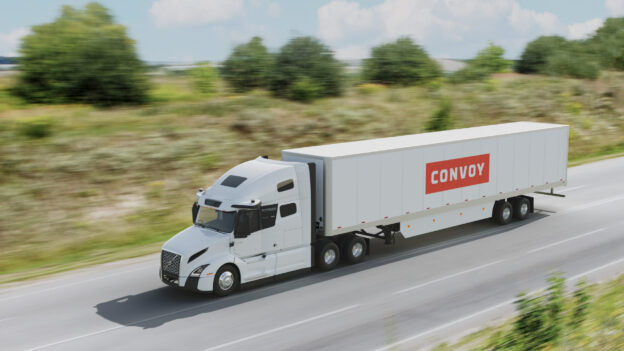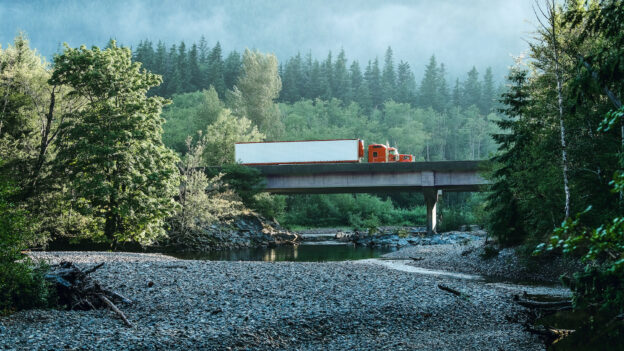The Cost Of Integrating Sustainability Into the Supply Chain
Sustainability • Published on July 20, 2020
Supply chain sustainability has been a growing topic of conversation in board rooms across the country for quite some time now, but it has been amplified even more as a result of COVID-19. The breakdown in supply chains as a result of the pandemic has forced many organizations to seek supply chain resiliency and identify ways to create a flexible supply chain which will systematically tackle challenges as they occur.

Traditionally, however, supply chain leaders are focused on cost first, and, for the most part, that is still true. But what if the debate was less about cost OR sustainability and more about cost AND sustainability? Harshad Kanvinde, Practice lead – Strategy & Supply Chain, Slalom Consulting, who has led several large scale transformation programs for multiple Fortune 500 companies to drive change participated in our video series The Business of Sustainability. Harshad shares his experience on how best to integrate sustainability into the supply chain.
More specifically, we wanted Harshad to offer advice about the following:
- What are the current challenges in supply chain?
- How do these companies think about the importance of creating a sustainable supply chain?
- When does it make sense for companies to invest in sustainability initiatives?
- What is the first step a business could take in their sustainability journey?
Harshad provides insights into how the sustainability conversation initially arose and the basics organizations were doing to simply check the box to comply with government regulations. He reviews where the pull toward sustainability is coming from — including the ask from consumers who view sustainability as a key driver in their purchasing decision — as well as the timing and manner in which a company can begin to take more significant steps to integrating sustainability into their supply chain.
Watch the video or read the transcription below.
TRANSCRIPTION
Jennifer Wong: Hi everyone. My name is Jennifer. I lead sustainability at Convoy. In this series, we’re interviewing business leaders to hear stories about sustainability in action. A handful of companies are capturing significant value in systematically integrating sustainability into their business. We want to share these learnings so every business can build sustainability into their business practice. Today we have Harshad Kanvinde joining us today. He is the Practice Lead for Strategy & Supply Chain at Slalom Consulting. He’s led several large-scale transformation programs for multiple Fortune 500 companies in industry sectors including CPG, retail, aerospace, automotive, and also technology. Welcome Harshad.
Harshad Kanvinde: Hey Jennifer. Nice to be here. Thanks for having me. Super excited to talk about sustainability.
Jennifer: Yes. I’m excited, especially because of your background. Strategy and supply chain, of course, so closely align to kind of our work at Convoy and I’d love to really dive into the sustainability part of people’s supply chain. And I think, just to kick things off, I’d love to hear from your point of view what you think the current challenges are in the supply chain. I think that’s one of the first problems that a lot of businesses always try to address.
Harshad: I think, COVID-19 for example, we are still in the midst of it and some of those issues are getting highlighted more now than before. But supply chain resiliency, it’s top of mind for people. How do I maintain my supplies? How do I keep the lights on? Right? But it’s the [inaudible 2:00] to that is how do I get a flexible supply chain so that when these kinds of things occur, I don’t need to scramble all the time and there should be a systemic way to tackle the challenges as they occur. So, supply chain resiliency and flexibility are definitely top of mind but what I’m seeing, Jennifer, is that traditionally supply chain leaders were focused on cost, and that’s still true. So, it’s not giving me resiliency and flexibility or even sustainability by compromising cost. Cost is still, if you rank up everything on top of a head of supply chain’s mind, cost still trumps everything else. So how can I deliver the best cost possible to my organization, to my business, so that it can reflect into pricing and so on for the benefit for the consumer. I think the slight change that I see though, somehow, and going into the topic of sustainability, sustainability is getting more and more integrated into that cost equation. It’s not that we need to deliver on the cost and on the side, we also need to do good things for Earth, for the environment, and for the people. So, it’s not an either-or conversation. The leaders in this space are understanding that it’s an conversation or an our conversation. So, being sustainable, also helps me deliver the best cost. Being sustainable, also helps me build a resilient supply chain that’s not dependent on one region, one supplier, and so on. So, I think its kind of, we are seeing a lot of integration, and especially in the leaders who have been practicing that muscle for endless years now.
Jennifer: Right, and as businesses are thinking about that integration and you mentioned that sustainability is just going to be an input to cost, how do these companies really think about the importance of creating [4:00] a sustainable supply chain, or how do they think about that modeling as this new type of integrated, almost scorecard is coming to light.
Harshad: So, it’s like the pool is definitely coming from the, and there are likely different reasons why companies are interested in sustainable supply chains. Obviously, there is the uber goal of being good and being a good corporate citizen. You don’t only serve your shareholders, but there are other stakeholders that are important. Your employees, your consumers, your communities that you operate in. Like the last 10 years or so I think there is from the consumer activation standpoint, consumers are asking for sustainable products. So that’s a big push. Then that has transferred into several regulations that are kind of demanding sustainable [inaudible 4:50]. How people started, if you look back, maybe 15 years back I think initially sustainability was just from the standpoint that we wanted to create some checkboxes to comply with certain regulations. That used to be the thinking and that’s how it started. But now more and more I think those same companies after 10 or 15 years of experience now there is a realization that most of these things can go hand in hand. So, for example, my consumers are looking for it for the product they consume, and they are looking for sustainable products, they are looking for cleaner, circular economies that create less and less waste. So that’s playing much more of a role than just complying with certain regulations. And that changes then how do you design the program internally and how you measure the success on those programs. There has been a change. So initially, it was just, these are the external standards we need to comply with for that [inaudible 5:51], we are starting a [inaudible 5:53] and just go through an exercise of at least creating a baseline of where we operate. Where it says now, we can now look at leaders [6:00] like Proctor and Gamble, Unilever, there are some other names and Amazon is doing great things. It’s much more than that. It’s much more than just complying. Working out those emissions goals. So, Microsoft, for example, announced the carbon negativity emissions. Similar kinds of emissions publicly disclosed by P&G and the universe of the world, Amazons of the world, go way beyond what the external agencies are asking you to do. These are fully driven, and again, it’s driven primarily by your consumers, also by your employees. So, I think the shape and design of the sustainability programs have changed drastically. I made a comment I think last month at some other discussion but it’s like innovation and sustainability go hand in hand. So, what do you do from the innovation supply chain? What do you do for the sustainability supply chain? They’re merging. It’s not two different answers. So, for example, as I do better to reduce my transportation costs, that also helps the environment. That also helps my sustainability goals. So, people are realizing that and we’re seeing a lot of innovation on those fronts.
Jennifer: Right. And so, for the businesses that are already investing in innovation, sustainability, I think those are the stories that the general public really hears about already. What about for the companies that haven’t yet invested in sustainability. When does it really make sense for a customer to really start investing in sustainability initiatives or start really thinking about how to integrate it into their business strategy?
Harshad: My opinion is the time is now. The time was yesterday because I think what, and many leaders realize this…I mean, you can ask the exact same questions for when is the right time to invest in digital, or when is the right time to invest in innovation. It’s like, now is always the answer. It takes time to build a muscle. [8:00] So, as I would say, Proctor and Gamble, Unilever and other leaders in this space, it’s a yearlong, an entire year long journey to get to a point where everything kind of starts fitting in together. So no matter how smart you are, if you don’t start at least measuring the base line where you are and putting the goals out there of what sustainability means to you and on the external regulations and compliance standards and so on. No matter who you are, I think starting now with the baselining, starting now with understanding your capabilities and what goals make sense to you because it could still take time. Just because you’re understanding, just because you put out lofty goals, it’s not an overnight thing. So, it takes time. It takes blood, tears, and sweat to go through the experiences firsthand. You can’t rob those from someone else’s learnings. So now is definitely the time. And I think a good thing that’s happening, and as you mentioned, there are many public stories, right? So, you go talk to the leaders in the space and there are many things happening across the world in their operations. They’re trying many things that are consumer focused and consumers are seeing the benefit. That at least kind of creates an angle. That creates the north star for the companies who have not started their journey and it shows that sustainability is not something that needs to be done by small groups of people outside of your core business. As you’re more integrated with your core business, there are more benefits to be had. So, there are no examples, and that creates the path for the new entrance so now is definitely the time.
Jennifer: Great. And just one last question before we wrap up today. So, sustainability, [10:00] we kind of talked about the time is now but it is a pretty big initiative. Especially when you think about how its integrated into your business. It’s not just a program that you put on top of your business. What would you say is just the first step a business could take just to start getting started on their journey here?
Harshad: So, I spent a little time, two years at Amazon, probably 6 years back. But personally, it was very transformative for me for a variety of different reasons. And I think one thing that sticks, I think a couple of things. Customer optimization is one thing and the other one is good intentions don’t work; good mechanisms do. Right, so a business always says that. So I think its super deep if you think about it and I would say that if you think about sustainability as something that you have to do because someone else is asking, that path only leads to failure and frustration. Even on day one as you start thinking about sustainability, you keep the customer front and center, or for that matter, your other stakeholders. Your employees and your communities that you operate in and it has to make sense. It has to be an “Ah, ha,” the okay, I get it. It should not feel like a band-aid, right? So, if that’s the message, then things become easier. Another thing is don’t start thinking about enterprise level skills. Start about your own business unit. If you are a manager in the business, start about the things that you are impacting day to day and what sustainability means. So you’re going to say before you start thinking about an enterprise program, start thinking about specific products, specific customer segments that you serve and their problems and how a sustainable solution, a sustainable supply chain helps solve those specific problems. If you start like that, then scaling [12:00] up is much easier and much more organic than kind of putting a band-aid on. Okay, we need to for PR purposes. We need to band-aid on our operation. That is just not going to go well. Because now, COVID-19, you will hear, and I have heard this from many organizations, unfortunately, that COVID-19, we are cash-strapped, liquidity is a problem, we are already facing issues, so we have stopped our innovation programs, we have stopped our sustainability programs. What that tells me is that you no, you were never serious about sustainability and you never started sustainability in a way that you should have. As one of my best friends working in this space, I’ll give a blip to James McCall from PNG, he said it super well. He’s like, “Just because financially things start becoming difficult, you’re not going to go back and make child labor okay.” Right? So, it’s still not okay. So, if you’re thinking about sustainability at a deep level, you’re not going to go back and stop those investments. When you see that happening, that means the depth in those programs should have been taught, and the depth has not happened. And that depth only comes when you connect that value proposition of sustainability, connect it super highly with the proper proposition to your customers and to your employees and to your communities.
Jennifer: Awesome. Well that was such great advice to end this with. Thank you so much for making time today.
Harshad: Thanks a lot Jennifer. Again, very happy to be here. Super excited to continue this discussion around sustainability. Thanks.
Jennifer: Great, thank you.



